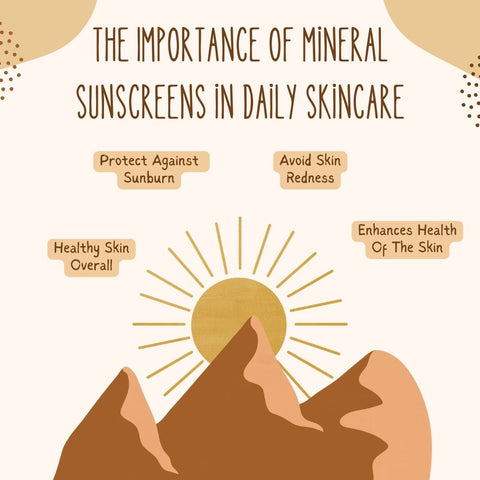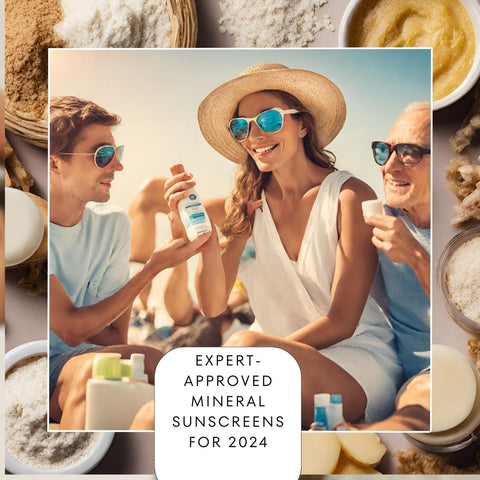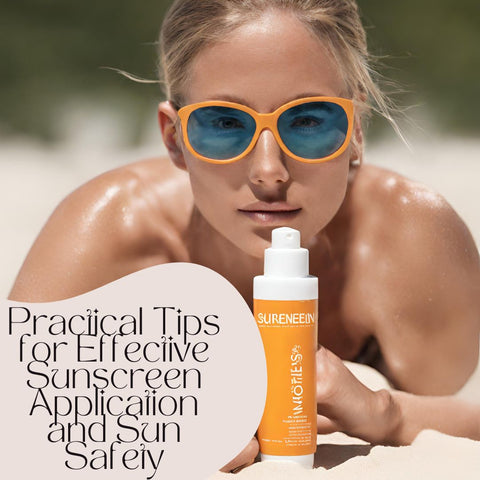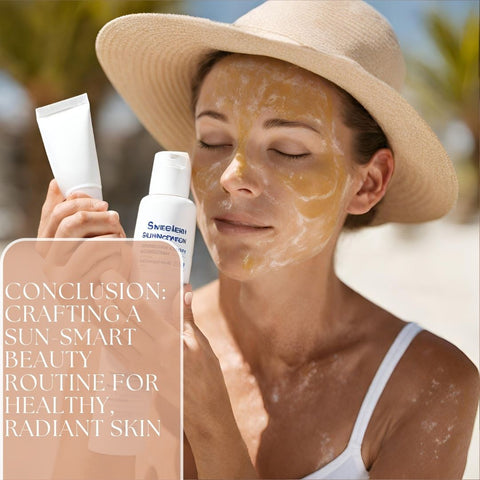Physical sunscreens, sometimes referred to as mineral sunscreens, usually have titanium dioxide and zinc oxide as active components. These minerals scatter and reflect UV rays from the skin, acting as a barrier. Because they are less prone to irritating chemical sunscreens, they are frequently chosen by those with sensitive skin. We'll talk about some of the top mineral sunscreen companies in 2024 in this blog.
Introduction: The Importance of Mineral Sunscreens in Daily Skincare

A fundamental component of any skincare regimen is shielding oneself from the sun's damaging rays to achieve healthy, glowing skin. Sunscreen is a vital tool in this fight against premature ageing, lowering the risk of skin cancer, and preserving the general health of the skin. Of the wide range of sunscreens on the market, mineral sunscreens have become more well-liked due to their special combination of advantages and adaptability to different skin types.
Physical sunscreens, often known as mineral sunscreens, set themselves apart from chemical sunscreens by using active mineral components like titanium dioxide and zinc oxide. These minerals serve as a barrier on the surface of the skin, deflecting and dispersing damaging ultraviolet (UV) radiation. The significance of mineral sunscreens in regular skincare regimens is becoming more and more clear as skincare research develops, especially for people with sensitive skin or those who favour clean, eco-friendly products.
Understanding the Difference: Mineral vs. Chemical Sunscreens
Sunscreen is an essential part of any skincare regimen since it protects the skin from the sun's damaging ultraviolet (UV) radiation. There are two main types of sunscreen to choose from: chemical and mineral sunscreens. Making educated decisions about these formulations based on personal preferences, skin types, and environmental factors requires an understanding of their distinctions.
Highlighting the Benefits of Mineral Sunscreens for All Skin Types
Mineral sunscreens, with their natural and physical barrier against harmful UV rays, provide a variety of benefits and are suitable for all skin types. Whether you have sensitive skin, are allergic, or simply want effective and broad-spectrum sun protection, mineral sunscreens offer compelling benefits. Here are some key advantages:
-
Mineral sunscreens, like zinc oxide and titanium dioxide, are generally well tolerated by sensitive skin. They sit on the skin's surface, creating a physical barrier that reduces the risk of irritation or allergic reactions.
-
Mineral sunscreens offer immediate protection from the sun. Mineral sunscreen formulations begin to function as soon as they are applied to the skin, in contrast to certain chemical sunscreens that require time to activate.
-
Mineral sunscreens provide broad protection against UVA and UVB rays. This broad-spectrum sunscreen helps prevent sunburn, premature ageing, and skin cancer.
-
Mineral sunscreens are more stable in sunlight than chemical filters, which can degrade over time. This stability ensures consistent and dependable protection during sun exposure.
-
Mineral sunscreens provide a protective layer on the skin's surface. This reduces the likelihood of the sunscreen being absorbed into the skin, which may be an issue for some people.
-
Mineral sunscreens are commonly recommended for children due to their gentle nature and physical barrier properties. They offer effective sun protection without the risk of skin irritation or the absorption of potentially harmful chemicals.
-
Mineral sunscreens, containing minerals like zinc oxide and titanium dioxide, are less harmful to marine life and coral reefs, making them environmentally friendly. Choosing mineral sunscreen helps to protect delicate ecosystems.
-
Mineral sunscreens typically offer longer-lasting protection compared to some chemical sunscreens. They are less likely to break down or lose effectiveness over time, making them a dependable option for long-term outdoor activities.
-
Mineral sunscreens with matte finishes are ideal for oily or combination skin. They are frequently non-greasy, allowing for convenient daily use.
-
Mineral sunscreens resist photodegradation and remain effective even after prolonged exposure to sunlight.
Expert-Approved Mineral Sunscreens for 2024

These mineral sunscreens were highly recommended:
It's important to remember that formulations can alter and that new goods might have joined the market. Furthermore, since every person has different skin types and preferences, it's a good idea to speak with a dermatologist or skincare expert for customised advice based on your unique requirements and skin concerns. Make sure the mineral sunscreen you select supports your skincare objectives by reading the most recent reviews and professional advice.
Exploring Top Picks for Broad-Spectrum and Reef-Safe Protection
Make sure to check for the most recent information and consult with experts for the best recommendations. Here are some top choices:
-
Dermatica Ray Protect Tint Mineral Sunscreen: Enjoy all-round protection from UVA, UVB, and Blue Light both indoors and outdoors with the Dermatica Ray Protect Tint Mineral Sunscreen. It is hybridized with light reflectants and absorbents infused into a non-sticky, lightweight, and quick-absorbing formula with a little touch of tint for easy and effective use for sun protection.
-
Rivela Lite Sunscreen SPF 50 PA++++: Rivela Lite Sunscreen SPF 50 PA++++ provides broad spectrum sun protection against UVA (skin ageing) and UVB (burning) rays. With a light brown shade gives a natural look. Water resistant and lightweight.
-
La Shield Fisico Matte Sunscreen Gel SPF 50+ PA+++: La Shield Fisico Matte Sunscreen Gel SPF 50+ PA+++ is a dermatologist-tested formula that contains Helioplex technology which provides superior balanced broad-spectrum protection against skin ageing UVA and burning UVB rays and combines it with dry touch technology for an ultra-light, non-shiny finish. This lightweight sunblock has a light, fresh scent and gentle enough even for sensitive skin.
-
360 Block Sunscreen Gel SPF 50+: 360° Block Sunscreen Gel SPF 50+ offers all-around protection against UVA, UVB, IR, blue light, and pollutants, preventing age-related concerns and hyperpigmentation. Its no-mess formula effortlessly absorbs into the skin for effective sun defense.
-
La Shield Pollution Protect Mineral Sunscreen Gel SPF 50 PA+++: La Shield Pollution Protect Mineral Sunscreen Gel SPF 50 PA+++ provides superior broad spectrum protection against UVA and UVB rays. It is clinically proven to defend skin's natural barrier function from microparticulate pollutants and also boosts skin hydration. It is suitable for all skin types.
-
La Shield Lite Sunscreen Gel SPF 50+ PA+++: La Shield Lite Sunscreen Gel SPF 50+ PA+++ protects skin against harmful UVA & UVB rays and absorbs easily into the skin without leaving a residue. Suitable to use both indoors and outdoors.
Remember to carefully read the ingredient list and product claims to ensure that a sunscreen is both reef-safe and appropriate for your needs. Additionally, consider factors such as water resistance, application frequency, and any specific skin concerns you may have when choosing a sunscreen. Reapply as needed and always adhere to the product's application instructions, especially after swimming or perspiring.
Reviewing Sunscreens with Non-Nano Zinc Oxide and Titanium Dioxide
The potential benefits of sunscreens containing non-nano zinc oxide and titanium dioxide, such as broad-spectrum protection and a decreased risk of skin irritation, make them highly sought after. Because they are bigger than nanoparticles, non-nano particles are preferred by certain people who are worried about possible skin or environmental absorption. Remember always that different people have different tastes and skin types, so what suits one person may not suit another. The correct application and reapplication of sunscreen are also essential for its effectiveness, particularly after swimming or perspiring. When selecting a sunscreen, take into account your unique requirements, such as water resistance and any skin sensitivity.
Discussing Water-Resistant and Dermatologist-Recommended Options
Water resistance and dermatologist recommendations are important considerations when choosing a sunscreen, especially if you participate in water activities or have specific skin concerns. Some water-resistant and dermatologist-recommended sunscreen alternatives include Dermatica Ray Protect Tint Mineral Sunscreen, Rivela Lite Sunscreen SPF 50 PA++++, La Shield Fisico Matte Sunscreen Gel SPF 50+ PA+++, 360 Block Sunscreen Gel SPF 50+, La Shield Pollution Protect Mineral Sunscreen Gel SPF 50 PA+++ and La Shield Lite Sunscreen Gel SPF 50+ PA+++. Remember to reapply sunscreen on a regular basis, especially after swimming or sweating, even with water-resistant formulas. Dermatologist recommendations can provide valuable information about products that are effective and appropriate for different skin types. If you have specific skin concerns or conditions, speaking with a dermatologist for personalised advice is always a good idea.
Practical Tips for Effective Sunscreen Application and Sun Safety

Proper sunscreen application and sun safety practices are required for effective sun protection. Here are some practical tips for getting the most out of your sunscreen and reducing the risk of sun damage:
-
Choose the Right Sunscreen: Choose a broad-spectrum sunscreen that contains SPF 30 or higher. Opt for water-resistant formulations, especially if you'll be swimming or sweating.
-
Apply Generously: Apply enough sunscreen to completely cover any exposed skin. Using one ounce or enough to fill a shot glass is a general rule of thumb for each application.
-
Apply 15-30 Minutes Before Sun Exposure: Before venturing outside into the sun, let the sunscreen absorb into your skin.
-
Reapply Regularly: Every two hours, or more frequently if you are swimming or perspiring, reapply sunscreen. It is imperative to reapply sunscreen after towel drying, even if it is labelled as water-resistant.
-
Pay Attention to High-Risk Areas: The ears, back of the neck, tops of the feet, and the scalp (if not covered in hair) are among the places that are susceptible to sunburn. Every exposed portion of the face, such as the lips, ears, and nose, should have sunscreen applied.
-
Apply Sunscreen Under Makeup: If you wear makeup, either layer sunscreen underneath it or use an SPF-containing makeup product.
-
Consider Sun-Protective Clothing: Long-sleeved shirts, hats, and sunglasses are all appropriate protective clothing. Look for clothing with a UPF (Ultraviolet Protection Factor) for added sun protection.
-
Seek Shade During Peak Hours: Limit sun exposure during peak hours, which are typically 10 a.m. to 4 p.m. Seek shade when possible, especially if you're in an area with intense sunlight.
-
Be Mindful of Reflections: Water, sand, and snow can reflect and intensify sunlight. Be extra cautious in these situations.
-
Protect Children: Use sunscreen formulated specifically for children. Keep infants under six months old out of direct sunlight and dressed in protective clothing.
-
Check Expiration Dates: Sunscreen efficacy can wane over time. Check the expiration date before using.
-
Be Consistent: Make sun protection a daily habit, even on cloudy days and in the winter. UV rays can penetrate clouds, causing skin damage even when the weather is not sunny.
-
Perform Skin Checks: Regularly check your skin for any changes or unusual moles. Consult a dermatologist if you notice any unusual changes.
Keep in mind that year-round sun protection is essential, and regular use of sunscreen and adherence to sun safety precautions promote long-term skin health. For individualised guidance, speak with a dermatologist if you have any particular skin issues.
Providing Guidance on SPF Ratings and UVA/UVB Protection
Understanding SPF (Sun Protection Factor) ratings and the distinction between UVA and UVB protection is crucial for effective sun care. Here's information on SPF ratings and the significance of UVA/UVB protection:
SPF Ratings: What is SPF? SPF is a measure of a sunscreen's ability to keep UVB (ultraviolet B) rays from harming the skin. How SPF Works: An SPF 15 sunscreen blocks about 93% of UVB rays, an SPF 30 blocks about 97%, and an SPF 50 blocks about 98%. Higher SPF values offer greater protection, but the increase is not linear. SPF 30 does not provide double the protection as SPF 15. Choosing the Right SPF: Dermatologists typically recommend using a broad-spectrum sunscreen with SPF 30 or higher on a daily basis. The American Academy of Dermatology recommends SPF 30 for the majority of people, but those with fair or sensitive skin may benefit from higher SPF levels.
UVA and UVB Protection:
-
Understanding UVA and UVB: UVB rays cause sunburn and contribute to the development of skin cancer. UVA rays penetrate the skin deeply, leading to premature ageing and increased risk of skin cancer.
-
Broad-Spectrum Protection: Choose a sunscreen labeled "broad-spectrum" to ensure protection against both UVA and UVB rays.
-
Ingredients for UVA Protection: Zinc Oxide protects against UVA and UVB rays. Titanium Dioxide offers UVA protection, but less effective against UVB.
-
PA Rating (UVA Protection): Some sunscreens, particularly in Asian countries, utilise the PA system. More "+" symbols indicate higher UVA protection.
Additional Tips:
-
Water-resistant sunscreens are recommended, especially if you are swimming or sweating. However, reapplication is still required following water exposure.
-
Apply sunscreen before applying makeup, or use makeup that contains SPF.
-
Wear protective clothing and hats, and seek shade, especially during peak sunlight hours.
-
Consider the UV Index when planning outdoor activities. Higher UV Index values indicate a greater risk of harm from unprotected sun exposure.
-
People with fair skin, a history of sunburn, or those taking medications that increase sun sensitivity may require additional protection.
-
Skin self-exams should be performed on a regular basis, and any changes or concerns should be reported to a dermatologist.
Remember that sun protection is a year-round commitment, not just on sunny days, and it is essential for preventing premature ageing and lowering the risk of skin cancer. To ensure the best protection, always follow the manufacturer's instructions.
Emphasizing Lightweight Formulas and Anti-Aging Benefits
Finding a sunscreen that not only offers efficient sun protection but also complements your skincare objectives is crucial when selecting a product with an emphasis on lightweight formulas and anti-aging advantages. The following advice relates to lightweight formulas:
-
Look for sunscreens in the gel or serum consistency. These formulations are frequently lightweight, easily absorbed, and suitable for daily use.
-
Choose sunscreen with a non-greasy finish. Lightweight formulas should absorb quickly, leaving your skin feeling smooth without a heavy or oily residue.
-
Consider using oil-free or water-based sunscreen. These are less likely to clog pores and are recommended for people who have oily or acne-prone skin.
-
Sunscreens with a matte finish are ideal for those who prefer a non-shiny appearance. They can be especially beneficial to people with combination or oily skin.
-
Some sunscreens offer both sun protection and other skincare benefits, such as hydration or antioxidants. Look for multipurpose formulas to streamline your routine.
Remember to use sunscreen every day, even on cloudy days, to protect your skin from the sun's harmful rays and maintain a youthful and healthy appearance.
Addressing Environmental Impact and Sustainable Sunscreen Choices
As people become more aware of environmental issues, it is increasingly important to choose sustainable and eco-friendly sunscreen options. Here are some considerations and recommendations for reducing the environmental impact of sunscreen choices:
Considerations for Environmental Impact:
-
Avoid sunscreens with oxybenzone and octinoxate, which have been linked to coral reef damage. Look for the "reef-safe" or "reef-friendly" labels.
-
Select sunscreens with biodegradable formulations that are less harmful to the environment.
-
Mineral sunscreens containing zinc oxide and titanium dioxide are often thought to be more environmentally friendly than chemical filters.
-
Consider water-resistant, biodegradable sunscreens to reduce the impact on aquatic ecosystems.
-
Check for microplastics in sunscreen formulations. Choose products without microbeads or microplastic particles.
Additional Tips:
-
Read the ingredient list and look for information on the label about reef-safe, biodegradable, or eco-friendly formulations.
-
Look for sunscreens with minimal and recyclable packaging. Some brands use environmentally friendly materials for their containers.
-
Be aware of local regulations and bans on specific sunscreen ingredients in areas with fragile ecosystems, such as coral reefs.
-
To reduce runoff, avoid using sunscreen excessively and apply it in and around water bodies with caution.
Choosing sustainable and environmentally friendly sunscreen options helps to protect ecosystems and promotes responsible sun care practices. Always check the most recent information, as formulations and recommendations may change.
Conclusion: Crafting a Sun-Smart Beauty Routine for Healthy, Radiant Skin

Developing a sun-smart beauty regimen is crucial to preserving skin health and radiance while considering the environment. Here is a summary of important factors to take into account: select mineral sunscreens; give preference to light-weight formulas; embrace the anti-aging effects; think sustainably; use appropriate application techniques; wear sun-protective clothing; stay informed about the impact on the environment; conduct routine skin checks; and practise mindful sun safety. By incorporating these habits into your daily routine, you support a more environmentally friendly and sustainable approach to sun protection while simultaneously giving priority to the health and vibrancy of your skin. Recall that regular care leads to healthy skin and that an effective skincare regimen must include a sun-smart beauty routine.















